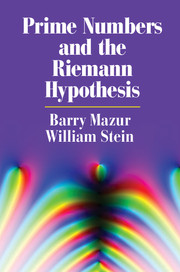Book contents
- Frontmatter
- Contents
- Preface
- PART I The Riemann Hypothesis
- 1 Thoughts About Numbers
- 2 What are Prime Numbers?
- 3 “Named” Prime Numbers
- 4 Sleves
- 5 Questions About Primes
- 6 Further Questions About Primes
- 7 How Many Primes are There?
- 8 Prime Numbers Viewed from a Distance
- 9 Pure and Applied Mathematics
- 10 A Probabilistic First Guess
- 11 What is a “Good Approximation”?
- 12 Square Root Error and Random Walks
- 13 What is Riemann's Hypothesis?
- 14 The Mystery Moves to the Error Term
- 15 Cesàro Smoothing
- 16 A View of|Li(X)-π(X)|
- 17 The Prime Number Theorem
- 18 The Staircase of Primes
- 19 Tinkering with the Staircase of Primes
- 20 Computer Music Files and Prime Numbers
- 21 The Word “Spectrum”
- 22 Spectra and Trigonometric Sums
- 23 The Spectrum and the Staircase of Primes
- 24 To Our Readers of Part I
- PART II Distributions
- PART III The Riemann Spectrum of the Prime Numbers
- PART IV Back to Riemann
- Endnotes
- Index
9 - Pure and Applied Mathematics
from PART I - The Riemann Hypothesis
Published online by Cambridge University Press: 05 May 2016
- Frontmatter
- Contents
- Preface
- PART I The Riemann Hypothesis
- 1 Thoughts About Numbers
- 2 What are Prime Numbers?
- 3 “Named” Prime Numbers
- 4 Sleves
- 5 Questions About Primes
- 6 Further Questions About Primes
- 7 How Many Primes are There?
- 8 Prime Numbers Viewed from a Distance
- 9 Pure and Applied Mathematics
- 10 A Probabilistic First Guess
- 11 What is a “Good Approximation”?
- 12 Square Root Error and Random Walks
- 13 What is Riemann's Hypothesis?
- 14 The Mystery Moves to the Error Term
- 15 Cesàro Smoothing
- 16 A View of|Li(X)-π(X)|
- 17 The Prime Number Theorem
- 18 The Staircase of Primes
- 19 Tinkering with the Staircase of Primes
- 20 Computer Music Files and Prime Numbers
- 21 The Word “Spectrum”
- 22 Spectra and Trigonometric Sums
- 23 The Spectrum and the Staircase of Primes
- 24 To Our Readers of Part I
- PART II Distributions
- PART III The Riemann Spectrum of the Prime Numbers
- PART IV Back to Riemann
- Endnotes
- Index
Summary
Mathematicians seems to agree that, loosely speaking, there are two types of mathematics: pure and applied. Usually – when we judge whether a piece of mathematics is pure or applied – this distinction turns on whether or not the math has application to the “outside world,” i.e., that world where bridges are built, where economic models are fashioned, where computers churn away on the Internet (for only then do we unabashedly call it applied math), or whether the piece of mathematics will find an important place within the context of mathematical theory (and then we label it pure). Of course, there is a great overlap (as we will see later, Fourier analysis plays a major role both in data compression and in pure mathematics).
Moreover, many questions in mathematics are “hustlers” in the sense that, at first view, what is being requested is that some simple task be done (e.g., the question raised in this book, to find a smooth curve that is a reasonable approximation to the staircase of primes). And only as things develop is it discovered that there are payoffs in many unexpected directions, some of these payoffs being genuinely applied (i.e., to the practical world), some of these payoffs being pure (allowing us to strike behind the mask of the mere appearance of the mathematical situation, and get at the hidden fundamentals that actually govern the phenomena), and some of these payoffs defying such simple classification, insofar as they provide powerful techniques in other branches of mathematics. The Riemann Hypothesis – even in its current unsolved state – has already shown itself to have all three types of payoff.
The particular issue before us is, in our opinion, twofold, both applied, and pure: can we curve-fit the “staircase of primes” by a well approximating smooth curve given by a simple analytic formula? The story behind this alone is marvelous, has a cornucopia of applications, and we will be telling it below. But our curiosity here is driven by a question that is pure, and less amenable to precise formulation: are there mathematical concepts at the root of, and more basic than (and “prior to,” to borrow Aristotle's use of the phrase) prime numbers – concepts that account for the apparent complexity of the nature of primes?
- Type
- Chapter
- Information
- Prime Numbers and the Riemann Hypothesis , pp. 30 - 31Publisher: Cambridge University PressPrint publication year: 2016



